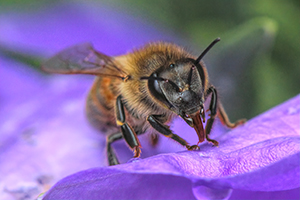
Dogs. Cats. Mice. Your next-door neighbor. What do they all have in common? One answer is a moveable lower jaw. In fact, lots of creatures have one movable jaw — known as a mandible — and one stationary jaw or maxilla. But your bees, along with many other invertebrates, have two movable jaws, both known as mandibles. Not only do they both move, but they swing in and out instead of up and down. Cool, right?
In bees, the mandibles are attached to the head at each end of the labrum. The labrum is a short, wide flap that functions much like an upper lip and protects the mouthparts when they are not in use. Each mandible is controlled by two muscles, the abductors and the adductors, which pull the mandibles in and out. At rest, the mandibles fold over the front of the labrum where they are barely visible.1
An All-Purpose Tool
Never underestimate the value of a bee’s mandibles. Before emergence until the end of life, bee mandibles are in constant use. The first thing a honey bee worker does with her mandibles is chew her way out of the cell where she developed from a fertilized egg. As she emerges, she perforates the capping until it opens like a manhole cover, and a nurse bee working in the area uses her mandibles to set aside the cap for later use.
Once free, the newly emerged worker goes back down the hole, head first, to prepare her brood cell for the next bee. Using her mandibles, she scrapes debris from the cell walls and polishes the waxen surface, assuring it is clean and smooth for the next sister. In the meantime, slightly older bees mend damaged comb or build new ones by using their mandibles to manipulate the wax.
Stabilizing the Proboscis
Among other things, bee mandibles are designed to stabilize the proboscis. The proboscis is a long and flexible multi-piece tongue that could be easily damaged, so the mandibles act like a portal to protect the tongue and support it while in use. When a bee is not using its proboscis, it is folded into a compartment inside the head, and the mandibles close over the front of the mouth, one over the other like a pair of crossed arms.
A study is now underway to determine which mandible folds over which. After looking at 50 members in each of 28 different species divided by sex, preliminary data show that it’s roughly 50/50. In other words, half the bees fold the right one in first and put the left one on top, while the rest do the opposite.2 The count for honey bee workers was exactly 50/50 — the perfect trivia question for your next bee club meeting.
Feeding the Young
One of the early jobs of a newly emerged worker is feeding the young larvae, and worker mandibles are perfectly designed for this task. The inner surface of each worker mandible is depressed into a spoon shape, and the depression is connected to each end of the mandible by a set of channels. By repeatedly opening and closing her mandibles, the brood food is squeezed from the worker’s glands and transported through the channel, filling the depressions behind the mandibles like a reservoir.1
When she is ready to feed larvae, the nurse bee places her mandibles in the brood cell and allows the food to flow from the reservoir into the cell. The worker parcels out the exact amount needed and then moves to the next, wasting nothing. She continues feeding until she must once again refill the reservoirs.
Jaws Fit for a Queen
The queen bee has mandibles, too, but hers are different. A queen’s mandibles are specially designed to cut through the tough layers of wax that form the cell where she matured from egg to queen. Unlike a worker cell with its flaky cap, a queen is sealed within thick and sturdy layers of wax. The queen must literally saw her way out of the cell, making a neat circular cut at the bottom end.3
But does the queen put away her mandibles once she’s free? No way. After emergence a new queen will search the brood nest looking for other virgin queens that may be still be resting inside their sealed chambers. When she finds one, she uses her mandibles to slice an opening in the side of the cell just big enough for her to back in and sting the unfortunate occupant. She will repeat this act again and again until she’s the last queen standing.
Drones, too, have mandibles, but since drones are not big on manual — or rather mandibular — labor, their jaws are very small. In fact, their mandibles are so small that drones often need help emerging from their natal cells, but with so many sisters close at hand, big mandibles are not necessary.
Beyond the Nursery
As you can see, mandibles play a vital role in the lives of young bees. But that’s just the beginning, especially for workers. Mandibles will play a role in almost everything a worker bee does for the rest of her life.
Comb building is an excellent example. Comb construction begins when young workers secrete wax from four pairs of glands under their abdomen. Although it oozes out in liquid form, the wax quickly hardens into ….


